Asklepios, the Greek god of healing and medicine, was known for his life-saving abilities.
Ironically, the genus of his botanical namesake, Asclepia, contains plants that can be killers. Asclepia is the genus of milkweed, which is giving us a brilliant show of purple and orange flowers. Common milkweed provides fragrant purple power, while butterfly weed is outrageously orange in the open fields. Both of these flowers have a unique and sometimes deadly system of pollination.
Milkweeds have their individual charms to attract pollinators, including scent (for some species) and the copious production of nectar to tempt and tantalize insects. If plants could have a type, milkweed’s would be winged insects. Butterflies, moths, bees and wasps easily gain their affection, while ants and other walking insects are less desirable due to their restricted ability to carry milkweed pollen far enough afield to assure effective cross-pollination.
Take a close look at milkweed’s flower and observe its distinctive structure. Each flower has five horned and hooded sections that contain nectar, while pollen is produced in two saddlebag-like sacs joined by a slit between the sections. Insects are attracted to drink from these cups, and while they are there, their legs slip into the slit where the pollen sacs, called pollinia, are contained. Pollen will become attached to the drinking insect’s legs in the hope of travelling to fertilize the next milkweed flower.
But this isn’t always the case. This pollen transfer isn’t always successful for the flower or the insect. Insects often get their legs stuck in these pollen sacs and will hang upside-down indefinitely until they are attacked and killed by other insects or die of starvation. A kind observer may free a stuck insect by gently pulling its leg out of this treacherous trap. Such a kind deed would certainly be appropriate to the memory of Asklepios, who, according to the Greek philosopher Cornutus, “derived his name from healing soothingly and deferring the withering that comes with death.”
In 1892, Dr. Charles Millspaugh, author of the laboriously-titled book, American Medicinal Plants: An Illustrated and Descriptive Guide to Plants Indigenous to and Naturalized in the United States Which are Used in Medicine, shared this observation of the phenomenon, “a large blue-bottle alighted upon the crown; as he did so one of his legs slipped down between two hoods, — which neatly curve to such a shape that the foot of an insect is guided directly into the crevice between two adjacent anther cells — and upon attempting to withdraw it, he was unable to do so. Noting this, I teased him into many strong tugs and pulls, but the more he struggled the tighter his foot became wedged, until finally, after about ten minutes’ hard work, he flew off with a little yellow spot (the pollen mass) attached to the extremity . . . thus executing without design the will of Nature.”
Those insects lucky enough to avoid that dangling fate assist milkweeds by moving pollen along to other plants. However, milkweed plants, too, are fighting the odds. While there may be hundreds of flowers on a single milkweed plant, only one to three per cent is properly pollinated. Not great odds for promising progeny.
Thus, insects and milkweed find themselves in a strange and distinctive dance, which is both life-threatening and life-giving. Luck will be in store for plant and animal if you believe Aristotle who might have been thinking of both asclepias and Asklepios when he said, “The physician heals, Nature makes well.”
Suzan Bellincampi is director of the Felix Neck Wildlife Sanctuary in Edgartown.




Comments
Comment policy »